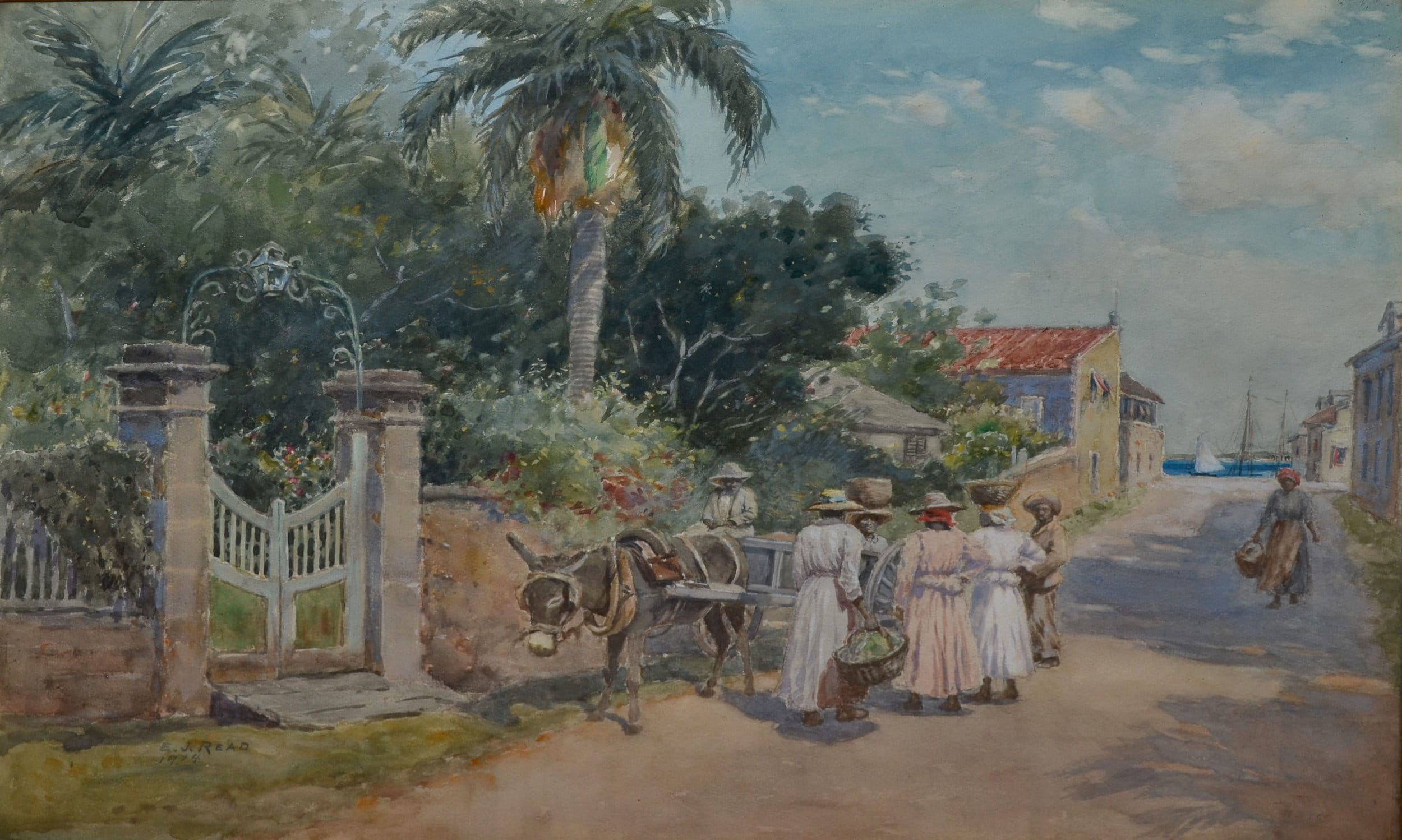
By Natalie Willis
Elmer Joseph Read, an American artist (b.1860, death date unknown), painted scenes of life in Nassau that provide a strange sense of documentary and fiction. They are stylised images, but the way Read tries to capture his perspective of life in the capital at the time is useful to us for a few reasons. It helps us to see how Nassau has changed over the years, and it also shows us how those who many modern day Bahamians are descended from were seen in that time. So many of the colonial paintings from this time use the iconography of smiling natives, women in headwraps, along with lush greenery and sea-glass ocean water as colonial propaganda. It gave a way to say, “Look how beautiful and safe and bountiful this empire is!” But these sentiments and picturesque ideals aside, uncomfortable as it may be at times, are still things we feel today, albeit in an evolved and shifted form.
Read captured The Bahamas at the turn of the century. Post-abolition and still reeling and reconfiguring, and figuring out this “third class British colony” as we were so disapprovingly called decades later by Edward VIII. A New Yorker, Read was a painter by profession, and travelled to The Bahamas and Cuba to work in the early 1900s. Trained at Syracuse University, as well as internationally at the National Academy of Design and the Art Institute in Chicago, Read’s training shows in the considered and yet still technical renderings in his work.
“East Street With Donkey and Cart” (1914) is a very different view of Nassau than the one we have today. Today we see it as the tourist center it is–and one may argue that it has almost always been this way–but whereas we now see the cruise ship dock and all the accoutrements of contemporary life, back in Read’s day it was clearly still quite busy and bustling, but with a clear and unobstructed view of the ocean. In 1966 the harbour was first dredged – over 50 years after Read’s version of the island. Before this, ships would have to anchor nearby and offer passage from ship-to-island on small boats and ferries.
How many Bahamians still have this open view of the ocean today? How many of us see pockets of this sparkling, thin, blue-green on every street leading to the heartbeat of the island at the ocean? Sure, if you were to drive down West Bay Street along that coastal road that’s a view, and parts of the East of the island. By and large, however, many Bahamians are denied easy access to this birthright – the right to these waters so renowned across the globe that so few get to enjoy in their unspoilt entirety in this country. Nassau has long since packed up the majority its coastline in commodified Georgie bundles to be sold, and Read’s work from this era serves as sobering and sad reminder of just how little we have been able to value our natural resources as something to celebrate amongst ourselves, rather than as an asset to entice visitors – which, while important, cannot be the only reason we love ourselves. The badly arranged marriage of The Bahamas and tourism has left us years later dissatisfied with ourselves, too tied up in one another to leave, and without a full knowledge of where one ends and the other begins. We have become our industry, rather than informing it, and that has left us feeling quite ironically washed up and beachless.
And the beach isn’t the only thing we sold, we also sold a dream. As we see in Read’s image the group of women chatting and going about their daily lives, we are reminded of the ongoing sale of the “smiling native”. Tourism does not have to be quite so insidious, but when you set yourself up as a country for others and not for yourself, you become a guest hotel with tired staff rather than a warm home welcoming in strangers. “East Street With Donkey and Cart” (1914) plays to both an image we know, and one we manufactured. On the one hand we see the idea of demure women in white who are toiling without complaint, but on the other we could see biggity gyals who are tired of toiling for free or next to nothing. The truth may lie somewhere between, and that makes much of this image so captivating.
Nestled between works that play with all the influences of the colonial era and modernism merging at that time, Read’s work in “Traversing the Picturesque: For Sentimental Value”, our recently opened exhibition of artwork in The Bahamas pre-1960, places us at our most classically idyllic time. Read was romance, leading the way for artist like Angelo Roker to splash in and experiment with bolder colours years later. Though some might be difficult, it all provides threads in this rich tapestry of our islands. “Traversing the Picturesque: For Sentimental Value” will be on view until Sunday, July 29th, 2018 at the National Art Gallery of The Bahamas.